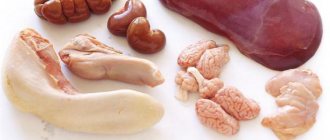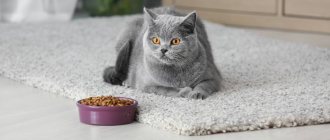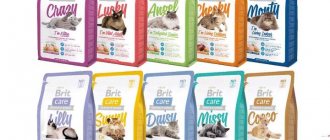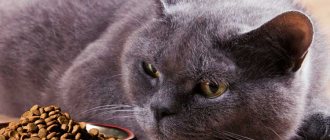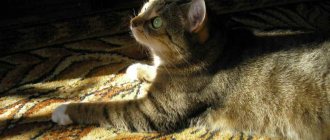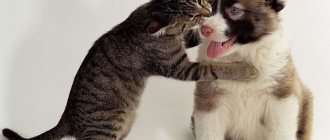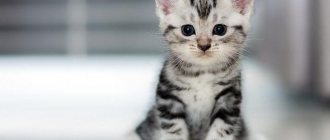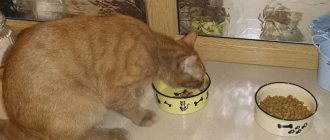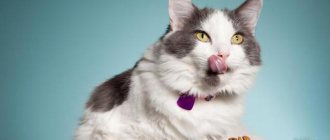October 25, 2018
If a kitten refuses dry food, then very rarely the problem is in the diet itself. Of course, cats have their own taste preferences, and they eat some foods more readily than others, but the reasons why a kitten does not eat dry food are most often of a completely different nature. These are exactly what we will look at in this article, and then we will move on to practical questions: what to do if the kitten does not eat dry food.
When force feeding is contraindicated
Animal instincts tell them a rational line of behavior, so a sick animal loses its appetite.
However, there are conditions where force feeding will actually do more harm than good. These are:
- Poisoning. In this case, actions are taken aimed at increasing the removal of the toxic substance from the body (artificially inducing vomiting, giving a cleansing enema, giving a laxative, intravenous infusions) and slowing down its absorption into the blood.
- Shock after injury. Pain and severe stress contribute to a sharp shift in metabolism and inappropriate behavior. As first aid, urgent measures are required to stop bleeding, fix the injured part of the body, as well as administer sedatives and cardiac drugs.
- Condition after anesthesia and surgery. Disorientation in space, dullness of sensitivity and disruption of muscle function lead to the loss of habitual behavioral reactions. Depending on the specifics of the surgical intervention, fasting is prescribed for 24-78 hours, and only after complete recovery from anesthesia and stabilization of the condition, dietary feeding with a gradual expansion of the diet is indicated.
- Acute gastrointestinal infection of a bacterial or viral nature. In this case, it is necessary to take emergency measures to relieve vomiting, diarrhea and general intoxication by introducing antibiotics, immunostimulants, sorbents, antispasmodics and detoxification drugs into the body.
- An attack of acute pancreatitis. For 2-3 days, the sick animal is shown fasting with intravenous administration of medicinal solutions, and only subsequently – fractional feeding in small portions.
Dehydration is much more dangerous than starvation, so drinking enough fluid or (in severe cases) intravenous infusion of special solutions that restore water-salt balance is a priority in all pathological conditions.
Cats don't eat, they feast on food. Make sure you don't get bored with the food
Another common reason why a cat has stopped eating dry food may be that the owners always offer the same taste. Try eating your favorite food three times a day for a month. Will it remain as desired and loved? What if you eat like this for a whole year? Most often, cats don’t eat, but treat themselves little by little. If your pet is tired of dry food, different flavors should be alternated .
Fortunately, now cat food is packaged in hermetically sealed bags; it will not spoil after opening the package.
The cat is tired of the taste or consistency
Cats, like people, get tired of the same food over time. If your pet eats the same food for a long time, he may simply get bored with it and want variety. If your four-legged pet suddenly begins to refuse his usual food, perhaps it’s not that it’s spoiled or the bowl smells of something, he just doesn’t like it anymore.
Refusal to feed is a kind of blackmail on the part of the tailed cunning creature. Thus, he tries to beg the owner for something more tasty. You should not force your four-legged picky eater to eat the food he usually eats. It is better to change the brand of food after coordinating your choice with your veterinarian. The transition from one finished product to another should be gradual. This process should take 1–1.5 weeks.
Attention to pet health
When introducing a new food, dry type, you should be attentive to how your pet feels. You should monitor what kind of feces the animal has, and whether there are any impurities in the urine. Complications that may occur include constipation and indigestion.
If such complications are detected, you need to stop introducing new food and show the cat to a veterinarian. It will be possible to resume feeding with ready-made food no earlier than after five to six weeks.
You will need to try another brand of food, but it must be high-quality and from a reputable manufacturer.
Kitten does not eat dry food: physiological reasons for food selectivity
We should start by looking at the natural diet of all cats. They are pronounced, typical predators. If the same dogs, in fact, are omnivores, and by old age they hardly need animal proteins at all, then with cats everything is different.
They always need food that is at least somewhat reminiscent of meat. Also, dietary fiber is extremely important for their digestive system, which in the wild is played by the veins, feathers and wool of small (and not too small) game. Accordingly, cats living in rural areas and regularly “feeding” on small rodents and birds often experience fewer digestive problems (however, the risk of helminthic infestations and poisoning increases sharply).
We provided all this information for one reason only - dry food itself is not natural for cats, and therefore any “normal” cat will treat it with some caution. The pet needs to be accustomed to it. A pet will always prefer high-quality canned or natural food, since its very nature “insists” on this.
The second reason lies in the natural food preferences of all cats. They, as a rule, always choose fresh food, the taste of which suits them. Unlike the same dogs, who can selflessly gorge themselves on any nearby garbage dump, choosing the most “fragrant” pieces there, cats are much more selective.
If they don't like the food, the animal will only eat if it is very hungry. Thus, if a kitten paws near the bowl, there is a high probability that he simply does not like the food. Changing the brand or manufacturer of the food often helps. However, there are pets who are almost always not satisfied with dry food.
If a little “picky” dog stubbornly refuses some type of food, it’s worth thinking about: perhaps this diet really doesn’t suit him, and therefore you shouldn’t force the kitten to eat. This, by the way, often happens when owners try to save a lot on food by buying the cheapest food for their pet. Considering that such “savings” often subsequently leads to the development of food allergies and digestive disorders, you should not insist on your choice.
What should the owner do?
The response directly depends on the cause of poor appetite. After finding out, you will have to eliminate the factors that irritate your pet, choose another feeding option, or take time to accustom him to unfamiliar food.
Determining the cause of feed rejection
If you detect alarming symptoms indicating the presence of pathology, you should not put pressure on the animal, forcing it to eat against its desire. In this case, simply contact your veterinarian. After treatment, your appetite will return on its own.
If your cat doesn’t eat dry food well, not because of illness, consider the specific situation:
- Loss of smell. With proper care, a mild cold will quickly go away on its own. If the olfactory function has disappeared due to old age, then it makes sense to switch to natural products with more pronounced odors.
- Hot weather or heat. Both situations resolve on their own after some time. You just need to make sure that your pet drinks the daily amount of water during fasting days.
- Increased anxiety. Create a comfortable corner where the animal can be alone. Give him enough attention to avoid jealousy of the new inhabitants and distract him from other irritating factors.
Is it necessary to soak dry cat food?
If we are talking about high-quality freeze-dried food - and our pets deserve only the best! - then they are completely ready for use and do not require any additions or preliminary preparation before use. Manufacturers of dry cat food claim that animals need to chew on these hard, crunchy kibble to strengthen their jaws and cleanse their teeth of plaque that precedes tartar.
Dry cat food is ready to eat
However, soaking the food will definitely not bring any harm to your pets - moreover, there are situations in which it is necessary to do this:
- during the transition from natural to freeze-dried food;
- when teaching small kittens to solid food;
- for animals with dental problems;
- for inflammatory diseases of the gastrointestinal tract;
- if the cat does not drink enough fluids;
- for aged and weakened animals;
- during rehabilitation after abdominal surgery.
A cat needs soaked food after surgery
How to soak food
How and with what to soak dry food? Many owners make the common mistake of pouring milk or broth into the granules to make the dish tastier for their pet. This cannot be done - only clean water, boiled or filtered, is suitable.
Only clean water is suitable for soaking feed.
For an adult cat
Most adult cats do not like food to be completely soaked into a puree; they prefer it to retain its structure. So the volume of liquid added and the soaking time must be determined experimentally based on the tastes of your pet.
Cats usually like food that is not too soggy
The finished food should be slightly warm - usually, in order to bring it to the desired condition, a quarter of an hour is enough at an initial water temperature of 60 degrees. The bowl in which the food is soaked can be covered with a clean saucer for safety. Before serving, the cat's dinner needs to be mixed thoroughly.
Consult your doctor: will the additives that you mix into the soaked food benefit your pet?
For small kittens
When transferring a suckling kitten from maternal feeding to a general diet, soaked food can serve an excellent purpose. This happens after the third week of life, and, of course, in such cases you need to use only starters - the very first foods for babies; Most reputable brands have such offerings.
The required portion of starter is poured into a clean bowl and poured with warm water so that it covers the granules. Stir from time to time and check how soft the food is - you will have to wait about half an hour. You can mash the finished food a little with a fork until smooth.
It is necessary to transfer kittens to an adult diet wisely and carefully.
Up to two or even three months, it is better to give kittens soaked food - in childhood, the digestive system is not yet perfect, and soaking will significantly simplify its work and improve the absorption of nutrients from food. It is advisable that until the animal reaches six months, half of the animal’s diet consists of soaked feed.
It is better for a kitten to soak dry food until it is six months old.
Is it possible to store this food?
There is no point in soaking a large portion of food at once or storing such cat food for future use. When wet, the food quickly turns into an unappetizing slurry, which also easily weathers, spoils and becomes a breeding ground for the proliferation of various undesirable microorganisms. Therefore, soak only as much food in water as your cat can eat at one time. Anything that remains should be thrown away after half an hour, and the bowl should be washed with hot water.
Soaked food spoils quickly
Small kittens and dry food: how to accustom pets to new food
Let us repeat once again: usually kittens are not particularly enthusiastic about dry rations. If you don’t accustom them to it right away, then later the animal will not eat it at all (or it will, but only after a long hunger strike). Also, the owner should not forget that the process of accustoming an animal to “unnatural” food is not quick.
This is done as follows:
- The kitten is given literally a pinch of dry food, previously soaked in meat broth (or in plain water). Let your pet get used to the smell and taste of the new food at least a little, so that in the future it does not cause him rejection.
- This is done for a couple of days, constantly adding soaked dry food at each feeding.
- After about five days, dry food can be introduced in an amount of 5% of the total diet.
- Within a week, the volume of “dry rations” is increased to 30%. If at this time there is a strong change in the consistency of the stool, or the kitten develops diarrhea or constipation, the diet should be immediately returned to normal. It is recommended to either change the brand of food or add it more slowly.
But! Until a young cat is at least six months old, his diet should consist of at least 50-60% of high-quality canned food or natural food. Until a year old, dry food cannot be the basis of the diet; it should be used exclusively as a supplement.
Neglect of this rule leads to digestive disorders, slow growth and development of the animal. This is especially true in the case of purebred cats, whose bodies are extremely demanding regarding nutritional characteristics at an early age. If you save a lot on the diet, then the cat will never be able to fully develop its breeding potential.
You should always observe “Nordic persistence”: if the breeder has firmly decided that the kitten should eat dry food, you should always ensure that it is eaten. Fasting days and alternating a dry diet with wet feeding will also help. But let us emphasize once again: if the cat stubbornly, even when hungry, does not eat, you should change the manufacturer and brand.
Important rules for transferring a pet to dry food from other types of food
When switching a cat to another type of food, you must follow several important rules:
- Taking into account the needs of the pet. The cat's preferences should be taken into account before offering another food. If your pet is a big fan of chicken, then it is unlikely that he will eat meat crackers. But indicating the type of meat on the package is not an advertising ploy, as many people think. A self-respecting manufacturer provides truthful information, which cannot be said about budget food. They use flavorings that are identical to natural ones. In addition, high-class industrial food is initially designed for the specific needs of the pet: to facilitate the removal of hairballs, for sterilized cats, for active cats. You should immediately take these nuances into account so that your pet receives a diet that suits its needs.
- Gradual means a gentle introduction of industrial feed into the diet. A sudden change is harmful and even destructive. It is enough to replace 1/10 of the usual portion with “crackers” and increase it daily by 1/10.
Every day you should replace only 1/10 of your pet’s usual diet with dry food.
- Time. The transfer from one type of feed to another should be carried out within 10–14 days. During this time, the cat will already taste new food. After this time, only the industrial product should be in the bowl.
- Unobstructed access to water. This is the most important rule when feeding commercial food.
The nuances of switching to dry food from different diets
Depending on what the cat ate previously, there are some nuances when switching it to dry food.
From wet industrial food
If the cat ate canned food, that is, wet industrial food, then everything is simple. In the first 2-3 days, crackers must be pre-soaked to the desired consistency. Gradually, soaking can be replaced with light moistening with the sauce from these canned foods. That is, mix the granules into a bowl, let it brew, and then offer it to the cat. At the last step, you can simply stir in either just the sauce or just the pieces. And after complete adaptation, leave only dry food.
From natural homemade food
The same rule applies here as with wet food. But cats are very suspicious animals and can easily recognize deception. Experts recommend starting with mixing canned food into natural food, and only then switching from wet industrial food to dry food. By the way, it will take the same amount of time: about two weeks.
There is another, simpler way: offer a dry food pellet as a treat. And specifically for a hungry pet. If no problems arise, then pour the food into the bowl during feeding hours.
My mother decided to switch her cat to dry food. I bought him a pack of Royal Canin. But the pet did not appreciate the taste or smell of the new food at all - he simply buried it with his paw, twitched his tail and walked away. Mom tried to soak it and mix it in, but the cat had no intention of even trying the new treat. Then they bought him a banal “Friskies”. It was he who ate him by both cheeks. But, of course, you can’t feed an animal with this product all the time. The next experiment was with Purina Van food. It fit perfectly too. And finally, the final product in this chain was Purina ProPlan food. Both the owner and the pet settled on it; it suits them in all respects. So if your cat refuses dry food, he may simply not like the taste or smell of this product. And never buy large packs of expensive food at once - there is a chance that you will have to feed it to street cats.
In case of partial replacement of other feeds with dry food
Many cats are not particularly mischievous and happily eat both wet and dry food. This is quite normal, especially if there is only one manufacturer. As a rule, problems with replacement do not arise here. The owner should only strictly decide at what hours he feeds dry food and at what hours he feeds wet food.
What to do
From the very first days of a kitten’s stay in the house, you need to decide what will be more convenient to feed it. If the choice falls on dry food, you need to accustom it to it from an early age. When exactly, you should consult a veterinarian.
If it is not possible to give your pet good premium and super-premium food, then it is better to feed your pet natural food:
- What is the difference between the feeds? Warnings regarding inexpensive feeds have good reason. They consist mainly of cereals, meat, and there are practically no high-quality offal in them. A caring owner will not feed such food to a small kitten, risking its health and even life. Economy class food should only be used as a last resort.
- The premium food group is more suitable for the diet of small kittens. Many manufacturers producing this product also include kitten food in their series. The food already contains more meat and less grains.
- The best option is super-premium ready-made food . Its components are only natural, there are no flavors or dyes.
If you can't spend a lot of money on super premium, you need to find a good premium brand. It is important to combine dry food with canned food. How to properly feed a kitten from the first months of its life can be found out from the veterinarian who is observing the pet.
Manufacturers indicate on the packaging the recommended serving for kittens of a given age; you should definitely follow these recommendations. If overfed, the kitten will quickly recover, but obesity can lead to serious illnesses.
Dry food is usually introduced into the diet at six weeks of age. But it’s better to wait until six months or a year. The period of getting used to such food will take some time, you need to be consistent and not rush. Dry food becomes complementary food, a supplement to milk. The addiction should become gradual.
IMPORTANT! You cannot suddenly change the nutritional system of not only a small kitten, but also an adult.
If a cat owner treats this issue irresponsibly, this can lead to big problems for the animal’s health. At best - diarrhea, vomiting, constipation. The digestive system can be seriously damaged and treatment will be necessary.
When purchasing a kitten from a breeder, owners usually receive a pet that is already accustomed to a certain type of food. You should find out the brand in order to give the animal the same food, at least for the first time.
Methods
To teach a kitten to eat dry food, you need to follow a certain order.
First, choose a quality food that smells good and doesn't have a lot of fat. Offer a little to your pet so that the kitten can taste and smell the product. If the kitten likes dry food, add food to the bowl and pour liquid on top so that the granules can soften. After this, the kitten can be fed with the resulting mixture or added to its usual food.
But if the kitten does not want to eat, then only dry food should be poured into its plate, and nothing else should be given until the baby tries the food. Using this method, your pet will develop a reflex. The kitten will understand that after dry formula he can be given his usual food. In order for the animal to get used to the dry mixture, it is necessary to reduce the amount of natural food. Start feeding more pelleted food. Slowly the pet adapts to the new taste qualities.
As soon as a few weeks have passed, the kitten can be completely transferred to a new type of food. All this time you need to observe the animal’s body. If your pet begins to experience constipation or diarrhea, he should be taken to a veterinarian, who will recommend a different food - perhaps the one purchased previously is not suitable.
Many veterinarians recommend not giving kittens natural food along with dry food, as this can lead to problems with the gastrointestinal tract. You can only check this from your own experience, since some kittens eat natural and dry food both as children and as adults, and nothing happens to them, while others begin to experience diarrhea after a couple of hours.
Features of feeding
There are several advantages to feeding dry food:
- It is easy to give the required portion, overfeeding occurs less often. Manufacturers provide a special table of the ratio of portions and weight, the age of the cat.
- Leaving the granules in the bowl for a while will prevent them from spoiling.
- Each manufacturer produces a large number of different types of food. They are intended for different breeds and different ages. There is food with medicinal properties for allergy sufferers.
- If one type of food is not suitable for the kitten, you can try another . The probability of finding the best option is high; a picky person who refuses such food will definitely like some of the food.
Reasons for refusing food
If your cat does not eat dry food, then the main thing is not to panic and identify the reason for this behavior. It is worth considering that a pet can simply take a small amount of food per day, because food swells in the stomach and very little is needed to saturate it. In hot weather or during heat, the animal should limit itself to a few grains.
The reasons can be harmless or dangerous. The main ones:
- The same food that your pet is tired of. Many owners believe that dry food will be enough to feed the animal. But his menu should consist of more than just one dish. A balanced diet will give your pet the necessary amount of vitamins and nutrients that are needed for the healthy development of the animal’s body. In order for your pet to absorb a sufficient amount of vitamins, it is worth adding soups, canned food, fish, meat, cereals, etc.
- Lack of appetite. This phenomenon occurs during the hot season. During this period, the animal behaves lazily and is not very hungry. Therefore, your pet should be fed twice a day: morning and evening, constantly changing the water.
- Improper storage. It happens that the owners do not follow the rules for storing the product and it becomes damp and loses its taste. To avoid this problem, you need to buy small packages that have a longer shelf life.
- Poor quality product. The kitten will not like the selected food because it does not suit its taste preferences. It can be either cheap or expensive. Therefore, before buying food, you need to study your pet's taste preferences.
- Dirty dishes. Representatives of the cat family are extremely clean, so their dishes must be perfectly clean.
- Appearance of the dishes. The design and shape of the bowl affects the feeding of the cat. When choosing dishes, you should give preference to neutral colors that will not scare away your pet. Therefore, you should choose ceramic and metal bowls.
- Pet stress. Loss of appetite in cats is also associated with stress. It occurs due to moving away from home, noisy company, the birth of a child, visiting a veterinarian, etc. The appetite will return within a week.
- The animal prefers natural food.
https://youtube.com/watch?v=isQFkoADTS4
These are not all the factors that can discourage a pet from taking dry food. There are many reasons, and the worst are diseases.
Diseases and poor health
If an animal stops eating not only dry food, but also regular food, then the reason for this is the onset of a painful process. It can be:
- poisoning;
- diseases of the gastrointestinal tract;
- problems with teeth or gums;
- kidney and urinary tract diseases;
- pathologies;
- parasites.
How to train
How to properly accustom a kitten to a ready-made diet? Veterinarians advise following the main rule - introducing new food gradually:
- When the kitten is two months old, you can replace part of its daily diet with dry food, but be sure to soften it first - in water, in broth, in milk.
- You can mix such a “new product” with already familiar food. Over time, the kitten will not perceive it as something alien and suspicious.
- The amount of dry granules gradually increases, this period should take about a month.
- To diversify the diet, you can periodically give natural food, this will also improve the functioning of the digestive system.
- Already at five months, the kitten can only eat ready-made dry food. He must have access to clean and fresh water.
- There should be a day in the week when the pet will eat canned food or natural products.
The food is spoiled
Sometimes owners think that the cat is tired of food, and they rush to the pet store to pick up something new. We hasten to assure you: the desire for variety is not typical for cats. In fact, they are quite conservative. And they have many fewer taste buds compared to humans, so gourmets are extremely rare among them.
If they like some food, they are ready to eat it all their lives, without requiring a menu update. But they sense odors very keenly, and when the food is spoiled, they immediately refuse it. It is easy to identify the problem by the following signs (one or more may be observed):
- the cat suddenly stopped eating dry food, which he had previously been willing to eat for months;
- the product’s expiration date indicated on the package after the words “Best before” or Best before (BB) has expired;
- the food was stored incorrectly: in a warm or humid place, in direct sunlight, in an open container;
- you have poured too much granules.
In the latter case, the fact is that with prolonged contact with air, the food ceases to smell intensely. It is smells that attract cats. If you add some fresh ones to the stale granules, your appetite will return.
Solution
Spoiled food will have to be thrown away and new packaging purchased. To prevent the food from losing its flavor while in the bowl, do not pour the daily amount at once, but divide it into at least two parts. The most sensitive individuals may require more feedings (4-5 per day).
I didn't really want to
It happens that cats who simply are not hungry refuse dry food, because in the morning they already begged for cheese, in the afternoon for a bag of cat treats, and in the evening they feasted on the leftovers of dinner. Is it any wonder that the dry food in the bowl remains untouched, and it seems to the owners that the cat does not eat it at all.
The solution to the problem is to completely eliminate any treats, both in the form of treats and kibble from the table, and not give the cat any other food except dry food. Hunger is not a big deal!
Stress in a cat's life is a likely cause of loss of appetite
The reasons why a cat refuses to eat dry food may be emotional in nature. It's time for March weddings, the summer heat, moving to a new apartment, a change of owner, the appearance of another pet in the house (and even the birth of a baby) can trigger a temporary refusal to eat.
What to do in such cases? Pay attention to the ward, try to create comfortable conditions, talk to him more often, stroke him
shutterstock
If after a couple of days the animal does not start asking for food again, then the reason is more serious and you should contact a veterinarian.
In cases where the cat asks for food but does not eat, you should check the quality of the purchased products. If you are happy that you were able to get your cat used to dry food at a price that suits your needs, and now you have found it at a cheaper price, in fact, it may turn out that the cat will ignore it. Sometimes the same brand is produced by different factories. Depending on the country of origin, the composition of the raw materials changes and the cat may not like this taste, while the owner is guided in the choice by the picture on the package and may not realize to read the information written in small print on the box.
The kitten is sick
You should really worry only when the kitten refuses any food, not just dry food. As a rule, loss of appetite is accompanied by other symptoms - lethargy, discharge from the nose and eyes, upset bowel movements, vomiting, and fever. In this case, you should definitely consult a doctor.
The most common reasons why a kitten does not want to eat dry food are the whims of the pet and the inappropriate composition of the product. Take these moments seriously, learn to understand dry food and start developing the right eating habits in your baby - then you won’t have any problems feeding your kitten.
The reason is in the bowl (dirty, smelly, etc.)
Cats are extremely clean animals. Their sense of smell is much sharper than that of humans, so they are able to smell even a faint odor. A pet may stop eating its usual food because the owner rarely washes the bowl or it smells unpleasant for reasons not related to untimely washing. Liquid from the bowl of water may leak into the container containing the dry granules. That is why it is recommended to place them at a certain distance from each other to eliminate this problem.
When moisture gets into the food, it begins to become damp. If the animal does not completely eat the food at one time, microorganisms grow in it, as a result of which it begins to smell unpleasant.
What can you do to restore your four-legged pet’s interest in food? To do this you need:
- Wash the bowl and pour boiling water over it. Subsequently, do this every day.
- Place the container of water away from the food bowl, making sure that the contents of the first cannot get into the latter. Some cat owners prefer to use double bowls. This is not the best option. It is recommended to feed cats from separate bowls.
- Pour into the bowl exactly as many granules as your pet can eat at a time. If he has not finished eating, it is recommended to pour the food back into the storage container, discarding the top layer on which the animal’s saliva has fallen.
- When purchasing food bowls, give preference to glass or stainless steel ones. Plastic containers may smell unpleasant. In addition, plastic is porous and almost impossible to wash clean.
What should the dishes be like?
It often happens that a cat refuses to eat food because the dishes are dirty and smell like something foreign. Therefore, it is very important that the bowl is always clean. It is better to give preference to ceramic and glass vessels, since these materials do not retain odors and are very easy to clean.
Read also: Why are there a lot of cattle in Russia?
But if the bowl is plastic or plastic, then it needs to be washed every day in warm water, making sure that no food particles or unpleasant smell remain.
What to do in such cases?
Owners often prefer dry ready-made food not only because of ease of use. A high-quality store-bought product is balanced in composition, it includes vitamins, micro- and macroelements, and other useful substances necessary for the pet’s body.
For normal functioning, your pet may require holistic nutrition.
Some animals require a strict diet. Holistic food will fully satisfy the needs of your pet, while simultaneously providing its body with everything it needs. However, the animal does not always agree with the owner and goes on strike and refuses to eat dry food. In such situations, veterinarians advise soaking the product in water, milk or broth, then offering it to your four-legged friend. It is important to give your pet water regularly so that it is always available. In addition, you should constantly monitor the cleanliness of the dishes from which the cat eats, because if it is dirty, the animal may refuse to eat.
You should not suddenly switch from one type of food to another. It is recommended to gradually introduce a new product, adding a larger portion each time, until you can completely displace the usual food from the menu. In addition, veterinarians do not advise frequently changing brands of manufacturers. It is better to choose food together with your doctor, taking into account the individual characteristics of the cat’s body.
Additional factors for avoiding dry foods
Above we listed the main reasons why kittens refuse dry food, but in practice there are other options:
- Weaning the kitten from its mother too early. In general, at such an early age, giving your baby adult food is strictly contraindicated. Firstly, the kitten's delicate teeth can be damaged by hard and hard granules. Cats have very thin tooth enamel! Old and low-quality food can easily damage it. Secondly, it is far from a fact that the digestive system of a young pet will generally be able to digest such food normally.
- It happens that the kitten was already eating dry food, but later stopped. This behavior is a sign that the cat is simply tired of the same food. You should diversify his diet with natural food or high-quality canned food. If dry and wet food alternate, your pet’s appetite will not disappear.
- Kittens should be fed small portions. Their size must be selected so that the animal eats everything in one go.
- Cats are clean people. They will not eat from a dirty and “filthy” bowl. It is necessary to regularly wash the bowl to remove any stuck pieces of old food.
- Moisten food with water or meat broth only in the first stages of accustoming your pet to it. Subsequently, the soggy and limp pieces will only cause rejection in the cat; she will not eat them.
- Constant refusal to eat is, in general, a very alarming sign. It doesn’t hurt the owner to try to give the pet something more appetizing than dry food. For example, a tempting piece of meat. If the cat doesn’t pay any attention to him, things are bad. You need to urgently call a veterinarian.
- Many owners love their cats so much that they constantly indulge their pets by putting excess food in their bowls. If an animal constantly overeats, you should not expect much appetite from it. Therefore, it is necessary to limit portion sizes, and before that, keep the kitten on a fasting diet for 12 hours (without restricting it in any way in water). This will not harm the animal’s health in any way, but it stimulates the appetite well (provided that the cat is healthy). If, even after starvation, he stubbornly refuses food, we strongly advise you to show the animal to a veterinarian (and the sooner the better).
The manufacturers themselves warn that after lying in a bowl for a day, dry granules absorb a lot of moisture from the surrounding air, and their components are subject to severe oxidation. All this leads to a serious deterioration in taste characteristics.
It is quite natural that the kitten will not eat such “old stuff”. However, eating oxidized and old food will not benefit him in any case, and therefore all leftovers that the baby has not eaten within several hours must be thrown away.
